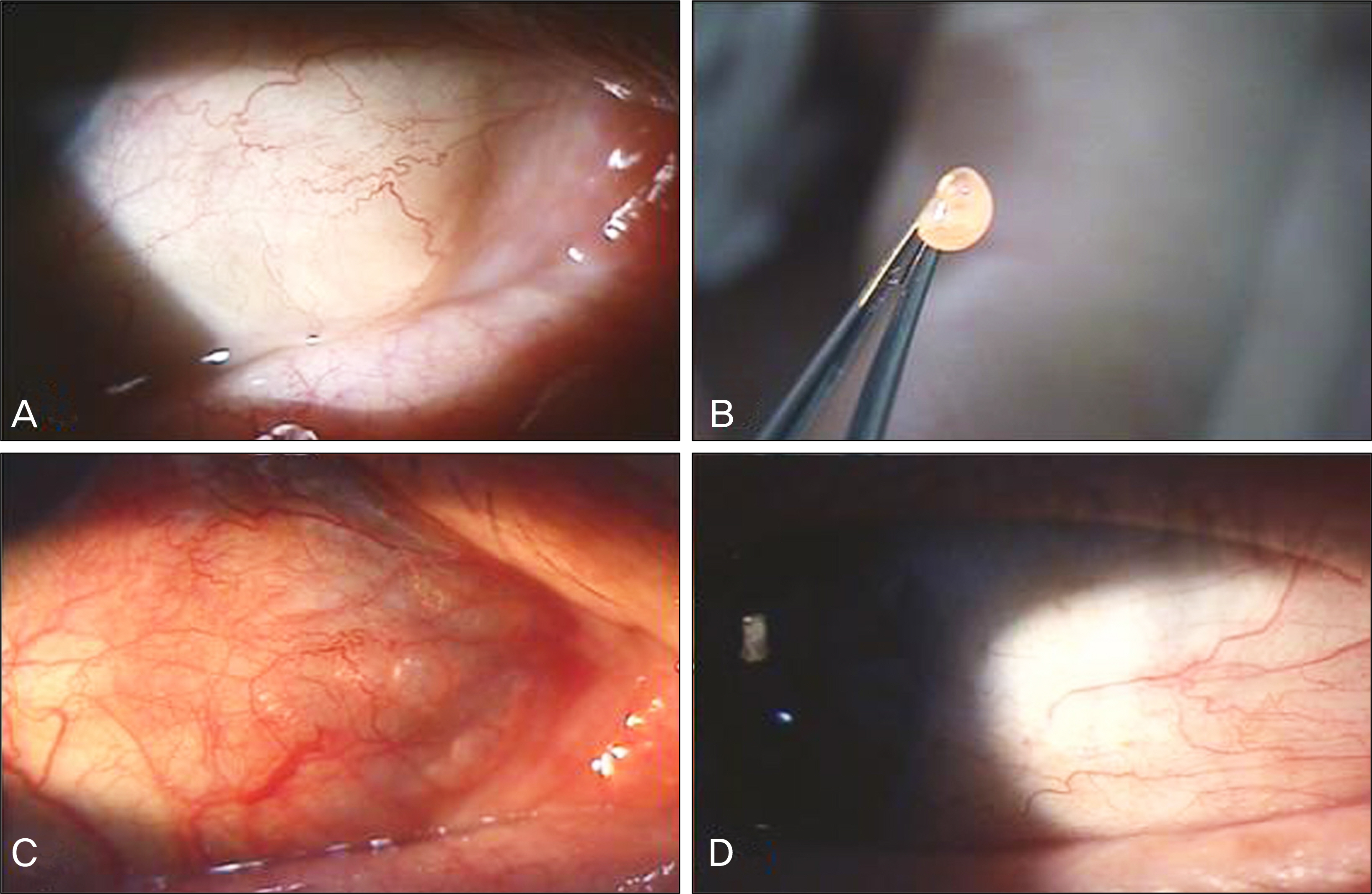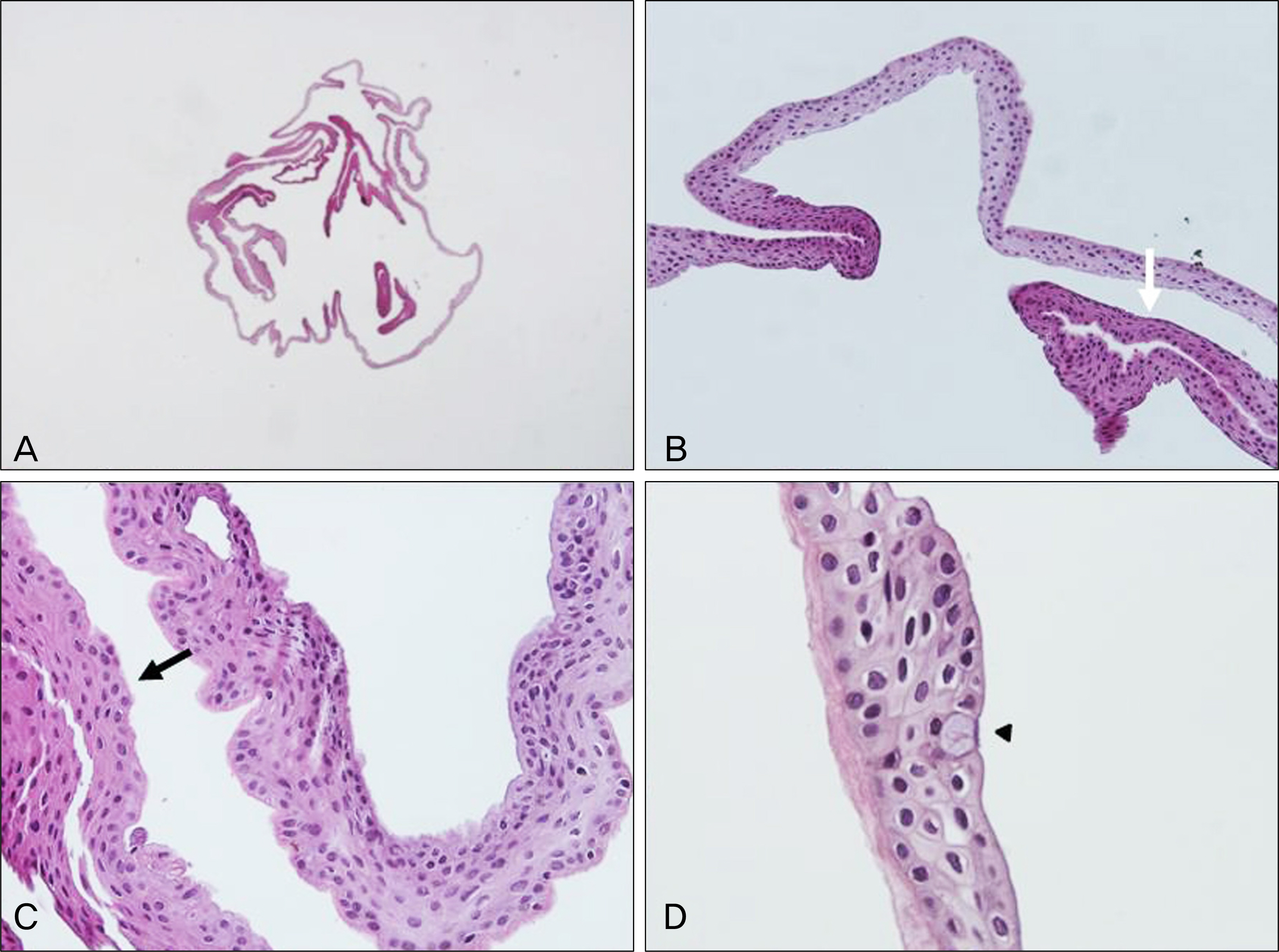J Korean Ophthalmol Soc.
2011 Dec;52(12):1531-1536. 10.3341/jkos.2011.52.12.1531.
A New Simple Technique for Removal of Subconjunctival Cyst under the Slit Lamp Microscope
- Affiliations
-
- 1Department of Ophthalmology, Yonsei University College of Medicine, Seoul, Korea.
- 2Siloam Eye Hospital, Seoul, Korea. nairwiny@naver.com
- KMID: 2215161
- DOI: http://doi.org/10.3341/jkos.2011.52.12.1531
Abstract
- PURPOSE
We present a new simple technique to remove subconjunctival cyst under the slit lamp microscope.
CASE SUMMARY
A cotton swab was used to verify whether or not the cyst was freely movable under the conjunctiva. After topical anesthesia, we incised the conjunctiva near the cyst using a 30-gauge needle and extracted the cyst through the wound using forceps under the slit lamp microscope. Four cases of subconjunctival cyst were successfully removed with our new technique. During the average five month (2-10 month) follow-up period, there was no recurrence or procedure-related complications.
CONCLUSIONS
Some subconjunctival cysts such as an epithelial inclusion cyst which is freely movable without attachment to surrounding tissues can be easily removed with a 30-gauge needle and forceps under the slit lamp microscope. This could be considered as the primary procedure instead of simple aspiration.
Figure
Cited by 1 articles
-
A Case of Conjunctival Inclusion Cyst Managed with Marsupialization
Hyo Sung Yoon, Min Joung Lee
J Korean Ophthalmol Soc. 2014;55(2):289-292. doi: 10.3341/jkos.2014.55.2.289.
Reference
-
References
1. Shields JA, Shields CL. Tumors of the conjunctiva and cornea. Smolin G, Thoft RA, editors. The Cornea. Scientific Foundations and Clinical Practice. 3rd ed.Boston: Little, Brown;1994. p. 586–95.
Article2. Aponte EP, Schoenfield L, Stern RM, Singh AD. A ductal cyst of lacrimal origin. Advanced Ocular Care. 2010. november/de-cember:29-30.3. Sameshima SS, Beyer-Machule CK. Acquired ptosis associated with a conjunctival cyst. Ophthal Plast Reconstr Surg. 1988; 4:159–62.
Article4. Srinivasan BD, Jakobiec FA, Iwamoto T, DeVoe AG. Epibulbar mucogenic subconjunctival cysts. Arch Ophthalmol. 1978; 96:857–9.
Article5. Brownell RD. Bulbar subconjunctival epithelial cyst. Am J Ophthalmol. 1960; 49:151–3.
Article6. Kotania W, Poniszowska I. Movable cyst in subconjunctival space (in Polish). Klin Oczna. 1969; 39:631–3.7. Bonamour MG, Bonnet M. Subconjunctival mobile cysts. Excision technic. Bull Soc Ophtalmol Fr. 1971; 71:299–300.8. Savar A, Nakra T. Freely mobile subconjunctival cyst. Ophthalmology. 2010; 117:637.e3–4.
Article9. Chan RY, Pong JC, Yuen HK, Lai JS. Use of sodium hyaluronate and indocyanine green for conjunctival cyst excision. Jpn J Ophthalmol. 2009; 53:270–1.
Article10. Kobayashi A, Sugiyama K. Visualization of conjunctival cyst using Healon V and trypan blue. Cornea. 2005; 24:759–60.
Article11. Kobayashi A, Saeki A, Nishimura A, et al. Visualization of conjunctival cyst by indocyanine green. Am J Ophthalmol. 2002; 133:827–8.
Article12. Kobayashi A, Sugiyama K. Successful removal of a large conjunctival cyst using colored 2.3% sodium hyaluronate. Ophthalmic Surg Lasers Imaging. 2007; 38:81–3.
Article





